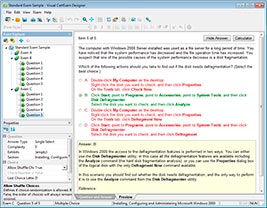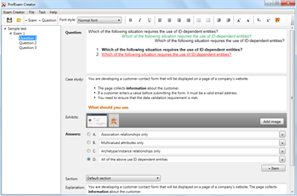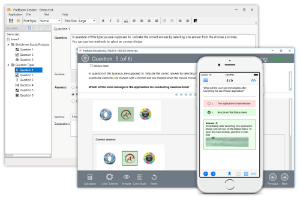Download AWS Certified Data Engineer - Associate.DEA-C01.CertDumps.2025-04-12.57q.vcex
| Vendor: | Amazon |
| Exam Code: | DEA-C01 |
| Exam Name: | AWS Certified Data Engineer - Associate |
| Date: | Apr 12, 2025 |
| File Size: | 88 KB |
How to open VCEX files?
Files with VCEX extension can be opened by ProfExam Simulator.
Purchase
Coupon: TAURUSSIM_20OFF
Discount: 20%
Demo Questions
Question 1
A banking company uses an application to collect large volumes of transactional data. The company uses Amazon Kinesis Data Streams for real-time analytics. The company's application uses the PutRecord action to send data to Kinesis Data Streams.
A data engineer has observed network outages during certain times of day. The data engineer wants to configure exactly-once delivery for the entire processing pipeline.
Which solution will meet this requirement?
- Design the data source so events are not ingested into Kinesis Data Streams multiple times.
- Design the application so it can remove duplicates during processing by embedding a unique ID in each record at the source.
- Stop using Kinesis Data Streams. Use Amazon EMR instead. Use Apache Flink and Apache Spark Streaming in Amazon EMR.
- Update the checkpoint configuration of the Amazon Managed Service for Apache Flink (previously known as Amazon Kinesis Data Analytics) data collection application to avoid duplicate processing of events.
Correct answer: B
Question 2
A company extracts approximately 1 TB of data every day from data sources such as SAP HANA, Microsoft SQL Server, MongoDB, Apache Kafka, and Amazon DynamoDB. Some of the data sources have undefined data schemas or data schemas that change.
A data engineer must implement a solution that can detect the schema for these data sources.
The solution must extract, transform, and load the data to an Amazon S3 bucket. The company has a service level agreement (SLA) to load the data into the S3 bucket within 15 minutes of data creation.
Which solution will meet these requirements with the LEAST operational overhead?
- Create a PySpark program in AWS Lambda to extract, transform, and load the data into the S3 bucket.
- Use Amazon EMR to detect the schema and to extract, transform, and load the data into the S3 bucket. Create a pipeline in Apache Spark.
- Create a stored procedure in Amazon Redshift to detect the schema and to extract, transform, and load the data into a Redshift Spectrum table. Access the table from Amazon S3.
- Use AWS Glue to detect the schema and to extract, transform, and load the data into the S3 bucket. Create a pipeline in Apache Spark.
Correct answer: D
Question 3
A company has a business intelligence platform on AWS. The company uses an AWS Storage Gateway Amazon S3 File Gateway to transfer files from the company's on-premises environment to an Amazon S3 bucket.
A data engineer needs to setup a process that will automatically launch an AWS Glue workflow to run a series of AWS Glue jobs when each file transfer finishes successfully.
Which solution will meet these requirements with the LEAST operational overhead?
- Determine when the file transfers usually finish based on previous successful file transfers. Set up an Amazon EventBridge scheduled event to initiate the AWS Glue jobs at that time of day.
- Set up an Amazon EventBridge event that initiates the AWS Glue workflow after every successful S3 File Gateway file transfer event.
- Set up an on-demand AWS Glue workflow so that the data engineer can start the AWS Glue workflow when each file transfer is complete.
- Set up an AWS Lambda function that will invoke the AWS Glue Workflow. Set up an event for the creation of an S3 object as a trigger for the Lambda function.
Correct answer: B
Explanation:
Using EventBridge directly to trigger the AWS Glue workflow upon S3 events is straightforward and leverages AWS's event-driven architecture, requiring minimal maintenance. Using EventBridge directly to trigger the AWS Glue workflow upon S3 events is straightforward and leverages AWS's event-driven architecture, requiring minimal maintenance.
Question 4
A company has multiple applications that use datasets that are stored in an Amazon S3 bucket.
The company has an ecommerce application that generates a dataset that contains personally identifiable information (PII). The company has an internal analytics application that does not require access to the PII.
To comply with regulations, the company must not share PII unnecessarily. A data engineer needs to implement a solution that with redact PII dynamically, based on the needs of each application that accesses the dataset.
Which solution will meet the requirements with the LEAST operational overhead?
- Create an S3 bucket policy to limit the access each application has. Create multiple copies of the dataset. Give each dataset copy the appropriate level of redaction for the needs of the application that accesses the copy.
- Create an S3 Object Lambda endpoint. Use the S3 Object Lambda endpoint to read data from the S3 bucket. Implement redaction logic within an S3 Object Lambda function to dynamically redact PII based on the needs of each application that accesses the data.
- Use AWS Glue to transform the data for each application. Create multiple copies of the dataset.Give each dataset copy the appropriate level of redaction for the needs of the application that accesses the copy.
- Create an API Gateway endpoint that has custom authorizers. Use the API Gateway endpoint to read data from the S3 bucket. Initiate a REST API call to dynamically redact PII based on the needs of each application that accesses the data.
Correct answer: B
Explanation:
Amazon S3 Object Lambda allows you to add your own code to S3 GET requests to modify and process data as it is returned to an application. For example, you could use an S3 Object Lambda to dynamically redact personally identifiable information (PII) from data retrieved from S3. This would allow you to control access to sensitive information based on the needs of different applications, without having to create and manage multiple copies of your data. Amazon S3 Object Lambda allows you to add your own code to S3 GET requests to modify and process data as it is returned to an application. For example, you could use an S3 Object Lambda to dynamically redact personally identifiable information (PII) from data retrieved from S3. This would allow you to control access to sensitive information based on the needs of different applications, without having to create and manage multiple copies of your data.
Question 5
A company is building an analytics solution. The solution uses Amazon S3 for data lake storage and Amazon Redshift for a data warehouse. The company wants to use Amazon Redshift Spectrum to query the data that is in Amazon S3.
Which actions will provide the FASTEST queries? (Choose two.)
- Use gzip compression to compress individual files to sizes that are between 1 GB and 5 GB.
- Use a columnar storage file format.
- Partition the data based on the most common query predicates.
- Split the data into files that are less than 10 KB.
- Use file formats that are not splittable.
Correct answer: BC
Question 6
A company is designing a data lake on Amazon S3. To ensure high performance when accessing the data, which best practice should the company adopt in organizing its data in the S3 bucket?
- Store all data files as a single large file and use AWS Lambda to parse required data segments.
- Partition data based on commonly accessed attributes and use a consistent naming scheme for prefixes.
- Use a flat structure by avoiding the creation of any prefix or "folder" hierarchy.
- Enable S3 Transfer Acceleration to ensure data is quickly accessible from any location.
Correct answer: B
Question 7
A company is migrating on-premises workloads to AWS. The company wants to reduce overall operational overhead. The company also wants to explore serverless options.
The company's current workloads use Apache Pig, Apache Oozie, Apache Spark, Apache Hbase, and Apache Flink. The on-premises workloads process petabytes of data in seconds. The company must maintain similar or better performance after the migration to AWS.
Which extract, transform, and load (ETL) service will meet these requirements?
- AWS Glue
- Amazon EMR
- AWS Lambda
- Amazon Redshift
Correct answer: B
Explanation:
Glue is like the more good-looking one, but weaker brother of EMR. So when it's about petabyte scales, let EMR do the work and have Glue stay away from the action. Glue is like the more good-looking one, but weaker brother of EMR. So when it's about petabyte scales, let EMR do the work and have Glue stay away from the action.
Question 8
A company is planning to migrate on-premises Apache Hadoop clusters to Amazon EMR. The company also needs to migrate a data catalog into a persistent storage solution.
The company currently stores the data catalog in an on-premises Apache Hive metastore on the Hadoop clusters. The company requires a serverless solution to migrate the data catalog.
Which solution will meet these requirements MOST cost-effectively?
- Use AWS Database Migration Service (AWS DMS) to migrate the Hive metastore into Amazon S3. Configure AWS Glue Data Catalog to scan Amazon S3 to produce the data catalog.
- Configure a Hive metastore in Amazon EMR. Migrate the existing on-premises Hive metastore into Amazon EMR. Use AWS Glue Data Catalog to store the company's data catalog as an external data catalog.
- Configure an external Hive metastore in Amazon EMR. Migrate the existing on-premises Hive metastore into Amazon EMR. Use Amazon Aurora MySQL to store the company's data catalog.
- Configure a new Hive metastore in Amazon EMR. Migrate the existing on-premises Hive metastore into Amazon EMR. Use the new metastore as the company's data catalog.
Correct answer: B
Explanation:
<> Migrating the Hive metastore into Amazon EMR and using AWS Glue Data Catalog as an external catalog provides a balance between leveraging the scalable and managed services of AWS (like EMR and Glue Data Catalog) and ensuring a smooth transition from the on-premises setup. This approach leverages the serverless nature of AWS Glue Data Catalog, minimizing operational overhead and potentially reducing costs compared to managing database servers. <> Migrating the Hive metastore into Amazon EMR and using AWS Glue Data Catalog as an external catalog provides a balance between leveraging the scalable and managed services of AWS (like EMR and Glue Data Catalog) and ensuring a smooth transition from the on-premises setup. This approach leverages the serverless nature of AWS Glue Data Catalog, minimizing operational overhead and potentially reducing costs compared to managing database servers.
Question 9
A company is planning to upgrade its Amazon Elastic Block Store (Amazon EBS) General Purpose SSD storage from gp2 to gp3. The company wants to prevent any interruptions in its Amazon EC2 instances that will cause data loss during the migration to the upgraded storage.
Which solution will meet these requirements with the LEAST operational overhead?
- Change the volume type of the existing gp2 volumes to gp3. Enter new values for volume size, IOPS, and throughput.
- Create snapshots of the gp2 volumes. Create new gp3 volumes from the snapshots. Attach the new gp3 volumes to the EC2 instances.
- Create new gp3 volumes. Gradually transfer the data to the new gp3 volumes. When the transfer is complete, mount the new gp3 volumes to the EC2 instances to replace the gp2 volumes.
- Use AWS DataSync to create new gp3 volumes. Transfer the data from the original gp2 volumes to the new gp3 volumes.
Correct answer: A
Question 10
A company is planning to use a provisioned Amazon EMR cluster that runs Apache Spark jobs to perform big data analysis. The company requires high reliability. A big data team must follow best practices for running cost-optimized and long-running workloads on Amazon EMR. The team must find a solution that will maintain the company's current level of performance.
Which combination of resources will meet these requirements MOST cost-effectively? (Choose two.)
- Use Spot Instances for all primary nodes.
- Use x86-based instances for core nodes and task nodes.
- Use Amazon S3 as a persistent data store.
- Use Hadoop Distributed File System (HDFS) as a persistent data store.
- Use Graviton instances for core nodes and task nodes.
Correct answer: DE
Question 11
A company maintains multiple extract, transform, and load (ETL) workflows that ingest data from the company's operational databases into an Amazon S3 based data lake. The ETL workflows use AWS Glue and Amazon EMR to process data.
The company wants to improve the existing architecture to provide automated orchestration and to require minimal manual effort.
Which solution will meet these requirements with the LEAST operational overhead?
- AWS Glue workflows
- AWS Step Functions tasks
- AWS Lambda functions
- Amazon Managed Workflows for Apache Airflow (Amazon MWAA) workflows
Correct answer: B
Explanation:
https://docs.aws.amazon.com/step-functions/latest/dg/connect-emr.htmlhttps://docs.aws.amazon.com/step-functions/latest/dg/connect-glue.html https://docs.aws.amazon.com/step-functions/latest/dg/connect-emr.html
https://docs.aws.amazon.com/step-functions/latest/dg/connect-glue.html
HOW TO OPEN VCE FILES
Use VCE Exam Simulator to open VCE files

HOW TO OPEN VCEX FILES
Use ProfExam Simulator to open VCEX files


ProfExam at a 20% markdown
You have the opportunity to purchase ProfExam at a 20% reduced price
Get Now!



